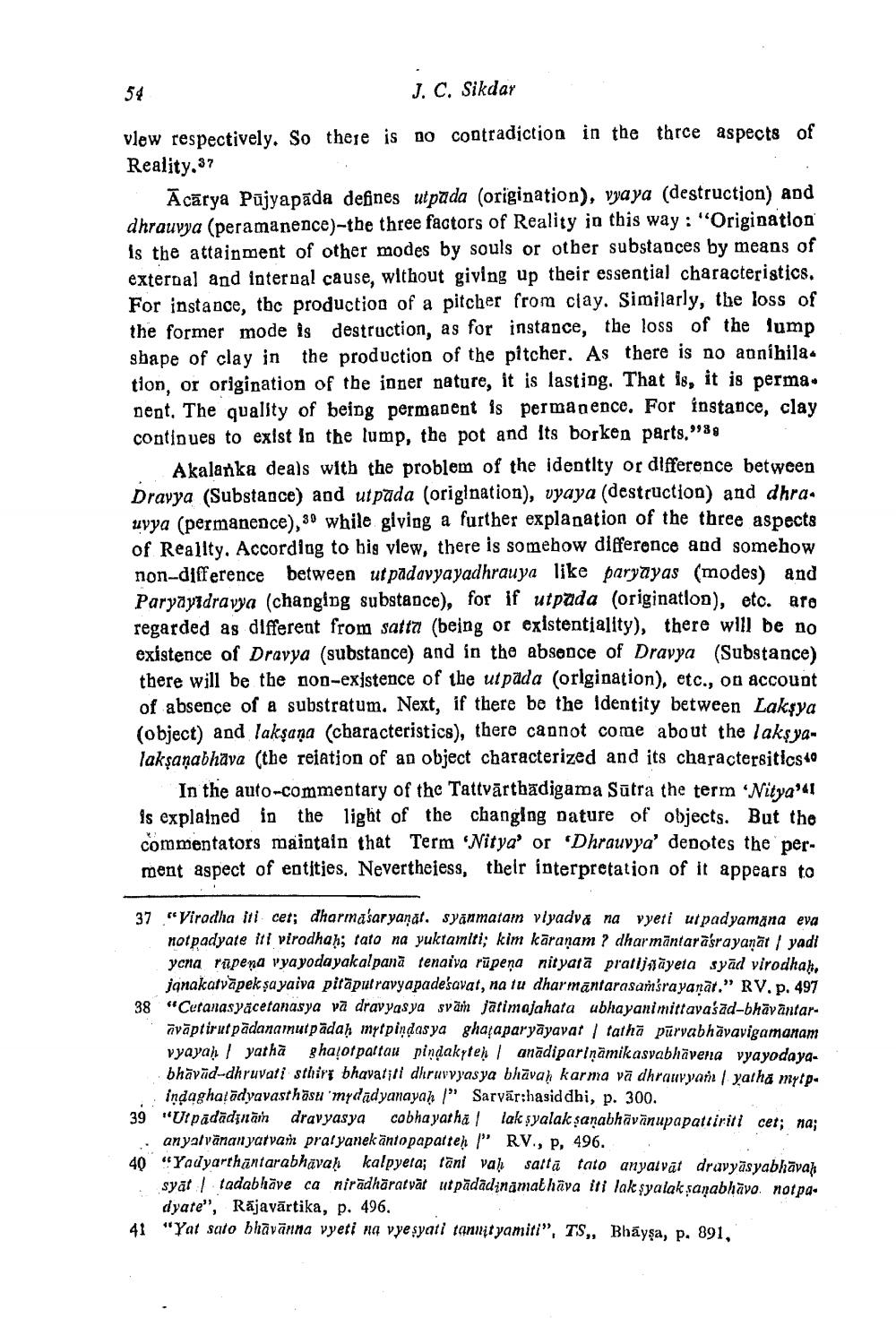________________
54
J. C. Sikdar
vlew respectively. So there is no contradiction in the thrce aspects of Reality,37
Acārya Pujyapāda defines utpada (origination), vyaya (destruction) and dhrauvya (peramanence)-the three factors of Reality in this way: "Origination is the attainment of other modes by souls or other substances by means of external and internal cause, without giving up their essential characteristics. For instance, thc production of a pitcher from clay. Similarly, the loss of the former mode is destruction, as for instance, the loss of the lump shape of clay in the production of the pitcher. As there is no annihila. tion, or origination of the inner nature, it is lasting. That is, it is perma. nent. The quality of being permanent is permanence. For instance, clay continues to exist in the lump, the pot and its bosken parts."8g
Akalanka deals with the problem of the identity or difference between Dravya (Substance) and utpada (origination), vyaya (destruction) and dhra. uyya (permanence), so while giving a further explanation of the three aspects of Reality. According to big view, there is somehow difference and somehow non-difference between ut padavyayadhrauya like paryayas (modes) and Paryāyīdravya (changing substance), for if utpada (origination), etc. are regarded as different from satta (being or existentiality), there will be no existence of Dravya (substance) and in the absence of Dravya (Substance) there will be the non-existence of the utpada (origination), etc., on account of absence of a substratum. Next, if there be the identity between Laksya (object) and laksana (characteristics), there cannot come about the lakşyalakṣaṇabhava (the relation of an object characterized and its charactersitics 40
In the auto-commentary of the Tattvārthadigama Sūtra the term 'Nitya'41 Is explained in the light of the changing nature of objects. But the commentators maintain that Term Nitya' or 'Dhrauvya' denotes the perment aspect of entities. Nevertheless, their interpretation of it appears to
37 “Viradha iti cet; dharmasaryanar. syanmatam viyadva na vyeti utpadyamana eva
notpadyate iti virodhah; tato na yuktamiti; kim karanam ? dharmāntarasrayanāt / yadi yona rapena vyayodayakalpana tenaiva rūpeṇa nityata prallināyeta syād virodhah,
janakatvāpek şa yaiva pitapulravyapadesavat, na tu dharmantarasasrayanar." RV. p. 497 38 "Ceranasyacetanasya vă dravyasya svam jarimajahata ublayani mittavasad-bhāvāntar
āvāptirut padanamutpädah mytpindas ya ghafaparyāyavar / tathā pūrvabhävavigamanam vyayah / yatha ghafor paltau pindakyteh / anādiparinamikasvabhävena vyayodayabhāvīd-dhruvati sthirt bhavatiti dhruvvyas ya bhāvah karma vā dhrauvyan yalha mytp
indaghatādyavasthāsu 'mydadyanayah !" Sarvār:hasiddhi, p. 300. 39 "Utpadādznāí dravyasya cobha yarha / lak syalak sanabhāvānupapatiiriti cet; na;
. anyaivänan yatvan pratyanekäntopapatten / RV., p. 496. 40 "Yadyarthantarabhavaḥ kalpyeta; tani val saitā tato anyalvāt dravyāsyabhāvah
syat / tadabhāve ca nirädhäratvat ut pādadinamathāva iti lak syalak sanabhāvo. notpa.
dyate", Rījavārtika, p. 496. 41 "Yat sato bhāvānna vyeti na vyesyati tannit yamiti", TS, Bhãyşa, p. 891,




